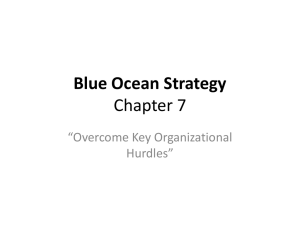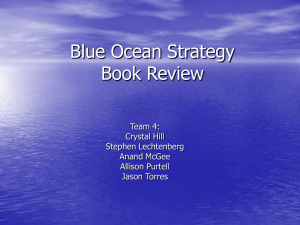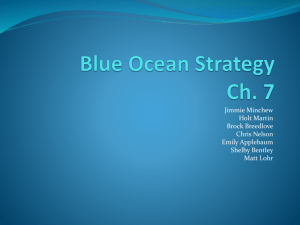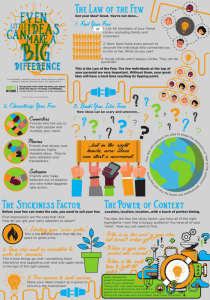Overcome Key Organization Hurdles Chapter 7 (BOS) Group 6
advertisement
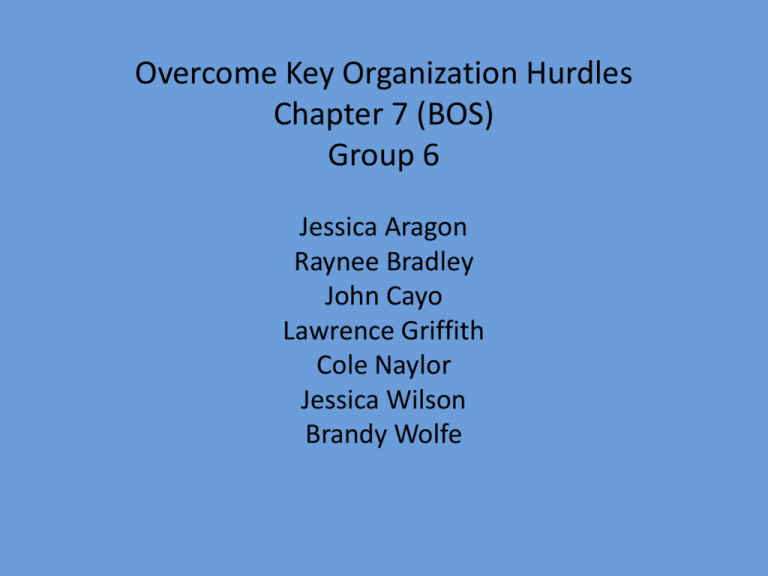
Overcome Key Organization Hurdles Chapter 7 (BOS) Group 6 Jessica Aragon Raynee Bradley John Cayo Lawrence Griffith Cole Naylor Jessica Wilson Brandy Wolfe Introduction • Once a company has developed a blue ocean strategy with a profitable business model, it must execute it. • Companies, like individuals, often have a tough time translating thought into action whether in red or blue oceans. • Compared with red ocean strategy, blue ocean strategy represents a significant departure from the status quo. • It hinges on a shift from convergence to divergence in value curves at lower costs. Organizational hurdles • There are four organizational hurdles companies face when implementing a strategic shift to a blue ocean: 1. Break through the cognitive hurdle Waking employees up to the need for a strategic shift. 2. Jump the resource hurdle The greater the shift in strategy, the greater it is assumed are the resources needed to execute it. 3. Jump the motivational hurdle How can companies motivate their employees fast and at low cost? 4. Knock over the political hurdle As one manager put it, “In our organization you get shot down before you stand up.” • Although all companies face different degrees of these hurdles, knowing how to triumph over them is key to attenuating organizational risk. Tipping point leadership & conventional wisdom • Conventional wisdom asserts that the greater the change, the greater the resources and time you will need to bring about results. • To overcome key organizational hurdles and make the blue ocean strategy happen in action, companies must abandon perceived wisdom on effecting change and implement tipping point leadership. • By implementing tipping point leadership it allows companies to overcome the four hurdles fast, and at low cost while winning employee’s backing in executing a break from the status quo. Tipping Point Leadership Allows you to quickly and cost effectively overcome the 4 hurdles to executing blue oceans: cognitive, limited resources, motivation and politics Organizational Hurdles to Strategy Execution Cognitive An org. wedded to the status quo Resource Limited resources Political Opposition from powerful Vested interest Motivational Unmotivated staff Tipping Point Leadership • Builds on the rarely exploited corporate reality that in every organization, there are people, acts, and activities that exercise a disproportionate influence on performance. • Mounting the challenge is about conserving resources and cutting time by focusing on identifying and then leveraging the factors of disproportional influence in an organization. Key Questions • What factors or acts exercise a disproportionately positive influence on: – Breaking the status quo – Getting the maximum bang out of each buck or resources – Motivating key players to aggressively move forward with change – Knocking down political roadblocks By focusing on points of disproportionate influence… • Tipping point leaders can topple the four hurdles that limit execution of blue ocean strategy quickly and cost effectively Break Through the Cognitive Hurdle The Cognitive Hurdle • The cognitive hurdle is the challenge of making people AWARE of the need for a strategic shift and to AGREE on its causes. • This is the hardest battle to overcome. • This section discusses the two most effective approaches to take in order to tip the cognitive hurdle fast. First, What not to do… • Pointing to numbers and insist on improvement. • This approach seldom works. • Its too abstract. • It doesn’t point out the people, acts, and activities that exercise a disproportionate influence on the overall performance. Tipping Point Leadership • It relies on the act of disproportionate influence: making people see and experience harsh reality firsthand. • Research shows that people remember and respond most effectively to what they see and experience: “seeing is believing” • Tipping point leadership builds on a touching, seeing, feeling approach to inspire a fast change in the mindset of the employees. • Instead of relying on numbers to tip the cognitive hurdle, they make people experience the need for change in two ways. 1. Make Employees Come Face-to-Face with the Worst Operational Problems • Numbers are disputable and uninspiring, but making people come face-to-face with poor performance is shocking and inescapable, but actionable. • Example: Ride the “Electric Sewer” 2. Meet with Disgruntled Customers • Not only must you get managers out of the office to see operational horror, but also get them to listen to disgruntled customers firsthand. • Do not rely on market surveys. • There is no substitute for meeting and listening to dissatisfied customers directly. • Example: Bill Bratton Jump the Resource Hurdle After deciding a strategic shift will be make, leaders must decide…Do we have the money to spend on necessary changes?? Typical leaders do one of two things: -Cut ambitions, also cutting work force morale -Fight for more money, a long, politically focused process Tipping point leaders concentrate on increasing the value of current resources by focusing on three factors: -Hot spots -Cold spots -Horse trading Redistribute Resources to Your Hot Spots • Hot spots are activities that have low resource input but high potential performance gains • NYPD ex: -Sharpest drop in subway crime with officers targeted at hot spots versus increasing police force size. -Major reallocation of staff and resources within the narcotics unit • By simultaneously assessing the NYPD’s cold spots, the resources were available to do this. Redirect Resources from Your Cold Spots • Cold spots are activities that have high costs but low performance impact • NYPD subway ex: – Processing criminals in court was costing the department valuable time officer’s could be using to patrol the subway – Bratton’s creation of “Bust Buses” • Restored buses became mini police stations and brought processing centers to the criminals • Cut processing time from sixteen hours to only one Engage in Horse Trading • Horse Trading involves trading excess resources for another unit’s excess to fill remaining resource gaps. • NYPD ex: Chief of NY Transit Police Dean Esserman played key horse trader along with Bratton – Transit unit needed office space and had an excess of unmarked cars, where as the NY Division of Parole was short of cars, but had excess office space. – Bratton refocused resources and broke out of the red ocean and executed its blue ocean strategy. 3 Factor Overview • By executing these 3 factors like a Tipping Point leader, resources are dramatically freed • The New York Transit Police greatly enhanced officer performance by assigning clear duties, narrowed in on crimes to focus on and where, and freed them from administrative hassles • To become a Tipping Point leader, you must do a number of things… – Seek out hot spots and concentrate resources on them – Figure out what activities have the greatest performance impact but lack the resources – Find your cold spots – Indentify resources in surplus and those that are scarce – Identify whether or not you have a horse trader, and what you can trade Jump the Motivational Hurdle How can you motivate employees fast and at low cost? Vs. • Typical Leader: Grand strategic vision that acts upon the assumption that to create massive reactions, massive actions are required. – Expensive and Time-consuming. • Tipping Point Leader: Seek massive concentration by focusing on the three factors of disproportionate influence in motivating employees. (Chief Bill Bratton) 1. Kingpins 2. Fishbowl Management 3. Atomization Zoom in on Kingpins • Kingpins = Key Influencers in the organization that can create a ripple effect by touching and motivating employees to embrace the new strategy. Level 5 Leader…? – Natural Leaders, well respected and persuasive, or have the ability to unlock or block access to resources. – As with kingpins in bowling, when you hit them straight on, all the other pins come toppling down. • NYPD ex: Kingpins = Precinct heads – Ease from direct control of police officers. Ex: Advertising Campaigns Word of Mouth, Print ads, Celebrities, and Fashion Trends Ideas, products, messages, and behaviors spread like viruses. Place Kingpins in a Fishbowl • Fishbowl Management: kingpins’ actions and inaction are made as transparent to others as are fish in a bowl of water. – Creates an intense performance culture. – Raises the stakes of inaction. • Must be based on: 1. Transparency – Shine a spotlight on kingpins. 2. Inclusion – Create a community. 3. Fair process – Engage all the affected people in the process to create a level playing field. Place Kingpins in a Fishbowl…cont’d • NYPD ex: Biweekly crime review meetings (Compstat) – Review the performance of precinct commanders in executing its new strategy. (peers and superiors) – Clear transparency in performance assessment and how it would tie into promotion or demotion, and clear expectations were set for everyone. – Performance culture: No kingpin wanted to be shamed, and they all wanted to shine. – Signals a level playing field and that leaders value employees’ intellectual and emotional worth. Atomize to Get the Organization to Change • Relates to the framing of strategic challenge. – Employees need to know that it is attainable, or the change will not likely succeed. • NYPD ex: To make the challenge attainable, Bratton broke it into bite-size atoms that officers at different levels could relate to. (Block by block, precinct by precinct, borough by borough) – Doable challenges…No one can say “It’s beyond me.” – Each member was only required to do his or her job. i.e. Officers on the street: Challenge – Make his or her block safe. Precinct Commanders: Challenge – Make his or her precinct safe. – BOS strategy shifted from Bratton to each NYPD member. Knock Over the Political Hurdle • Vested interests will always exist to resist any impending changes. • To overcome these political forces, tipping point leaders focus on three disproportionate influence factors: • Leveraging Angels • Silencing Devils • Getting a Consigliere Angles, Devils, and a Consigliere • Angels- those who have the most to gain from the strategic shift. • Devils- those who have the most to lose from a strategic shift. • Consigliere- a politically adept but highly respected insider who knows in advance all the land mines to be encountered by a strategic change. Leverage Your Angels and Silence Your Devils • To knock down the political hurdles, you should also ask yourself two sets of questions: – Who are my devils? Who will fight me? Who will lose the most by the future blue ocean strategy? – Who are my angels? Who will naturally align with me? Who will gain the most by the strategic shift? • By doing so, you will be able to discourage the war before it has a chance to start! Knock Over the Political Hurdle • Do you have a consigliere in your top management team? • Do you know who will fight you and who will align with you? • Have you built coalitions with natural allies to encircle dissidents? • Do you have your consigliere remove the biggest land mines? Challenging Conventional Wisdom • Transforming the extremes will transform the masses • Leveraging tipping point leadership • Focus on acts of disproportionate influence • Align employees’ actions with the new strategy
